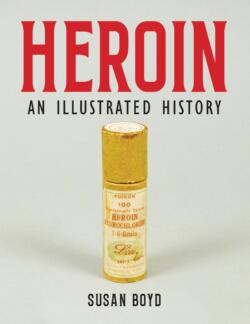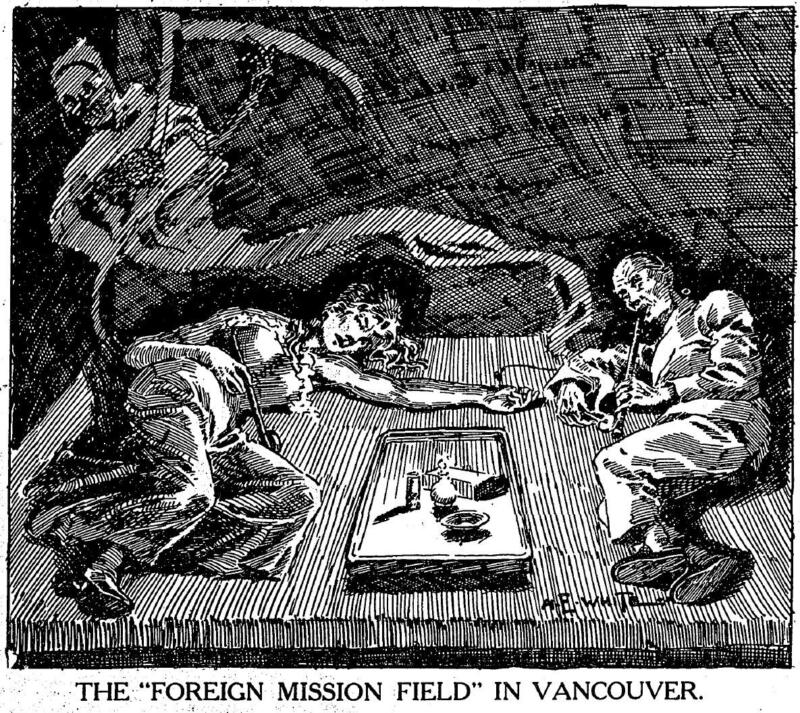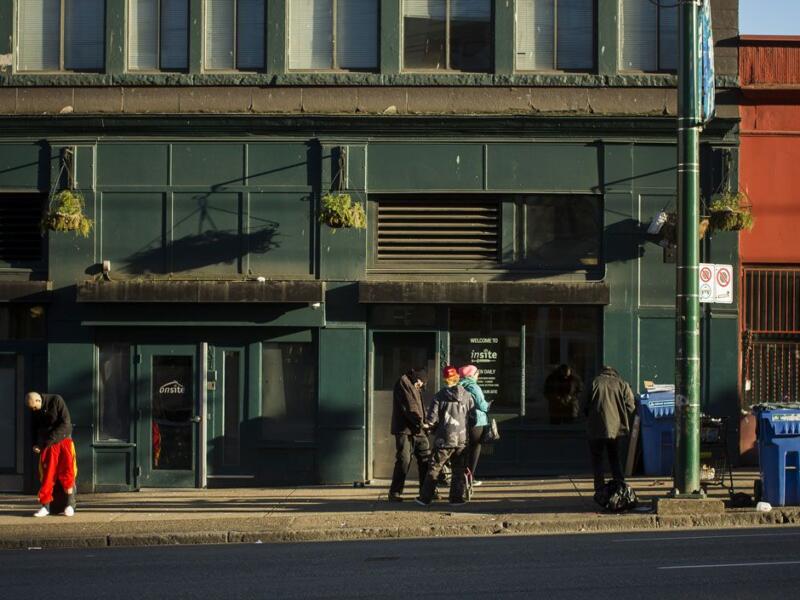1638 Regulating opiates & opioids
Heroin: An Illustrated History
by Susan Boyd
Winnipeg and Black Point, NS: Fernwood Publishing, 2022
$34.00 / 9781773635163
Reviewed by Connor Robinson
*
 Susan Boyd’s Heroin: An Illustrative History is a timely and illuminative record of how heroin, and opiates/opioids at large, moved from a drug with continued therapeutic relevance to a political tool for demonization and capitalistic control. Boyd’s narrative follows in the same critical footsteps as her earlier books — Busted: An Illustrated History of Prohibition in Canada (Fernwood, 2017, reviewed here by Erika Dyck) and Raise Shit! Social Action Saving Lives (Fernwood, 2009, with Bud Osborn and Donald MacPherson) — by using images and text to challenge Canadian and British Columbian drug policy. The current responses, Boyd argues, continually fall behind the calls from people who use drugs (PWUD) and advocates to provide life-saving, humanizing interventions — if at all. Policy and institutions that regulate drug use still primarily criminalize and pathologize the drug and people who use it. And Boyd makes it vibrantly clear that this stigmatization has its roots in the legislative control of minority populations, settler colonialism, capitalism, and white supremacy.
Susan Boyd’s Heroin: An Illustrative History is a timely and illuminative record of how heroin, and opiates/opioids at large, moved from a drug with continued therapeutic relevance to a political tool for demonization and capitalistic control. Boyd’s narrative follows in the same critical footsteps as her earlier books — Busted: An Illustrated History of Prohibition in Canada (Fernwood, 2017, reviewed here by Erika Dyck) and Raise Shit! Social Action Saving Lives (Fernwood, 2009, with Bud Osborn and Donald MacPherson) — by using images and text to challenge Canadian and British Columbian drug policy. The current responses, Boyd argues, continually fall behind the calls from people who use drugs (PWUD) and advocates to provide life-saving, humanizing interventions — if at all. Policy and institutions that regulate drug use still primarily criminalize and pathologize the drug and people who use it. And Boyd makes it vibrantly clear that this stigmatization has its roots in the legislative control of minority populations, settler colonialism, capitalism, and white supremacy.

After a brief first chapter that situates the current discourse around heroin, drug use, and harm reduction, Heroin proceeds chronologically from pre-1900s Indigenous uses of plant medicine to the present-day overdose crisis in British Columbia fuelled by the influx of fentanyl and benzodiazepines in the toxic street supply. Time begins to dilate as Boyd moves through her historicization. This dilation is a brilliant move on Boyd’s part as it allows for her to begin weaving multiple threads about heroin’s proliferation and its eventual criminalization. Her argument for how heroin moved from the branded medicine created as an upgraded, more cost-effective alternative to opium and morphine, to the addictive scourge it is viewed as today stems from the settler-colonial project of creating an “imagined white Christian Canada” (pp. 71-72).

Boyd points out that opiates in general were not originally seen as immediately addictive and destructive products. Rather, these drugs were seen as having beneficial pharmacological uses that outweighed the negatives. One could purchase opium in Western countries over the counter in the 19th century and not fear the criminalization that stigmatizes users today. However, as Boyd outlines, Christian sobriety movements conflated the idea of sobriety with sanctity to challenge the dispensing of opiates and alcohol into consumers’ hands. The Indian Act of 1876 showcased this intertwining of Christianity, settler-colonialism, and control by prohibiting the sale of alcohol and, eventually, opiates to Indigenous populations. This is one of many drug policies in Canada that target specific populations based on race, class, legal status, and so on. These policies, Boyd argues, highlight how opiates had to be symbolically and legislatively labelled as immoral for there to be policies to control these drugs and the people that use them.

Boyd’s argument circles around the idea that moral legislation of drugs was, and continues to be, a boon to Canada’s regulatory institutions. There is a financial incentive to control other populations that hinder this “imagine white Christian Canada.” For example, Boyd highlights how the RCMP’s enforcement of opium and narcotics in the 1920s led to “more police powers, bigger budgets and increased surveillance” (p. 76) of othered populations. Drug-related arrests and convictions increased and more money went to combat these rising criminal statistics. More cops looking for illicit drugs will, of course, lead to more criminal possession arrests. And we see this rhetoric continue today (November 22, 2022) with recently-elected mayor Ken Sim’s promise to hire 100 more officers and 100 more nurses to combat the rise in drug-related crime centred around Vancouver’s Downtown Eastside (DTES).

But do greater institutional powers and regulations really help what is slowly being accepted as a medical crisis rather than a crisis of criminality? Boyd thinks not. Her arguments aim for breadth and not always depth. We see this when she includes brief critiques of how cultural commodities, namely film, music, and tv series, create a spectacle of drug use that is tied up in immorality, deviance, and criminality. These inclusions look great on full-page spreads. I especially like the poster for the film Reefer Madness with its line “Women cry for it — men die for it!” Pure camp. Now viewers smoke a joint and laugh at the chaos this film depicts. Yet these asides act more as cultural reference points than deep dives into the relationship between consumer culture and legislation. Heroin gestures to how pervasive this ideology of drug use and immorality is in everyday discourse. But this pervasiveness is deserving of a book-length study in itself.
Italian Philosopher Giorgio Agamben has argued that “it is impossible for the subject of an apparatus to use it ‘in the right way.’”[1] While Agamben’s argument focuses on the relationship between technology and the subject, we can use this mode of thinking to consider how people who use drugs continue to be failed by the systems, or apparatuses, that govern the response to illicit drug use and overdoses. We can even argue that there is no “right way” for PWUD to access these regulatory systems “in the right way.” Instead, PWUD are reorganized and depersonalized in alienating ways to eliminate any trace of drug use from their biopolitical existence. The crux of Boyd’s argument is how these regulatory bodies frame PWUD as extraneous and superfluous entities who are a burden to capitalistic growth.


In response, Boyd outlines grassroots and peer-led movements from the DTES that gained traction in the 1990s as a response to the continued emphasis on treatment modalities that centred on sobriety and penalization. Safe injection sites began to pop up and frequent protests called for more government action to intervene in the rapid spread of HIV/AIDs and overdose deaths. But as Boyd makes clear, PWUD are still aware that the government has not been a reliable apparatus for effective intervention in the overdose crisis. The Drug User Liberation Front and Vancouver Area Network of Drug Users held a protest on July 14, 2021, in response to the government’s inaction regarding open and accessible safe supply. “Outside of the Vancouver Police Department,” Boyd notes, “… organizers provided a tested supply of heroin, cocaine and methamphetamine to drug organizations to distribute to their members ‘in an ethical way’” (p. 214).
With restrictions around who can access safe supply and what safe supply really means in a healthcare context, this rally cut through all the metaphors to emphasize that safe supply means non-toxic versions of the drugs they buy on the street: heroin, cocaine, methamphetamine, and even fentanyl, but not Dilaudid or morphine, which are common substitutes for those seeking a safe supply from their prescriber for opioid use disorder. This rally, along with others Boyd outlines in later chapters, showcases PWUD taking action into their own hands to offer clear solutions to intervene in the ongoing overdose crisis.


Susan Boyd’s Heroin: An Illustrated History acts as a necessary starting point for those who wonder how we got ourselves into this crisis today. It also acts as a refresher for those who are versed in drug policy, drug use, activism, or harm reduction from Canadian and British Columbian perspectives. Its vast subject matter is breathtaking, but it leaves me with more questions than I began with. Boyd recognizes this drawback. She cannot write herself out of this historical crisis we are currently facing. Another book will be written to document this unfolding narrative. “Illegal drug overdose death is preventable,” she argues, “yet our policy sustains them” (p. 164). Unless those who are most affected by these prohibitory policies are given autonomy in how to use and what they have access to use, PWUD will never truly be free from harm. And with drug overdose deaths reaching all-time highs in British Columbia, we must do more than hope that these changes come sooner than later.
*

Connor Robinson is a recent graduate of Simon Fraser University’s Master of Arts program. He currently lives in Vancouver and works in community health and harm reduction in Vancouver’s Downtown East Side.
*
The British Columbia Review
Publisher and Editor: Richard Mackie
Formerly The Ormsby Review, The British Columbia Review is an on-line book review and journal service for BC writers and readers. The Advisory Board consists of Jean Barman, Wade Davis, Robin Fisher, Barry Gough, Hugh Johnston, Kathy Mezei, Patricia Roy, Maria Tippett, and Graeme Wynn. Provincial Government Patron (since September 2018): Creative BC. Honorary Patron: Yosef Wosk. Scholarly Patron: SFU Graduate Liberal Studies.
“Only connect.” – E.M. Forster
References:
[1] Giorgio Agamben, What is an Apparatus? And Other Essays (Stanford: Stanford University Press, 2009, translated by David Kishik and Stefan Pedatella), p. 21.
